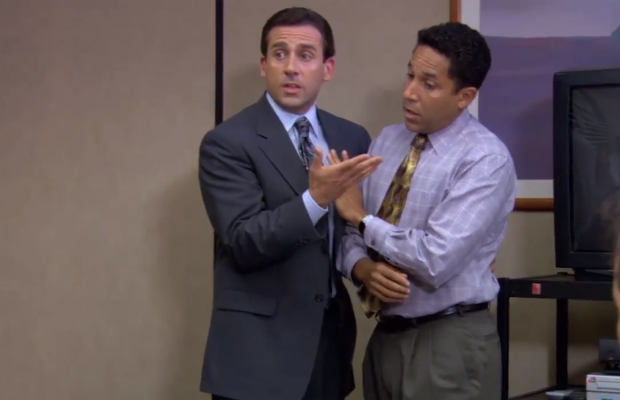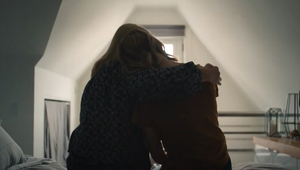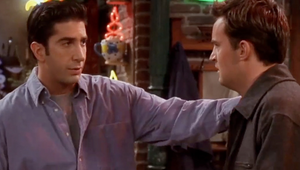
The One Where a Specialist Hospital Portrayed Famous Sitcom Characters with HIV

Canadian agency Bensimon Byrne has been working with HIV/AIDS hospital Casey House for the past three years. In that time they’ve launched several innovative, big-hitting campaigns focused on smashing stigma around the infection. There was the world's first HIV+ eatery, inspired by research that revealed many people wouldn't like to be cooked for by an HIV+ chef. And then another world first - a HIV+ spa, the result of similar research based on touch.
This year's campaign is different in its execution but just as far-reaching. It explores how popular culture has the power to change perceptions of those living with HIV/AIDS, and does so with 'never-before-seen’ episodes of Friends and The Office in which protagonists become HIV+. It's the result of combing through hundreds of hours of Friends and The Office before meticulously editing clips back together to tell the story of Joey’s ignorance in the face of Chandler’s HIV diagnosis (Friends) and a toxic office environment when Oscar discloses he lives with HIV (The Office). What's more, professional impersonators lent their voices, lookalikes replaced actors' mouths and a painstaking post production process pieced it all together. It all lives on https://smashstigma.ca.
Joseph Bonnici, partner and executive creative director at Bensimon Byrne, chatted to LBB's Addison Capper about the project.
*NB: Since publishing this story not so long ago, Casey House and Bensimon Byrne had to remove its adaptation of Friends after receiving a takedown notice under the U.S. Digital Millennium Copyright Act (DMCA) issued by Warner Bros. You can read a statement on that at the bottom of this interview.
LBB> What kind of brief did you receive from Casey House? And what were your immediate conversations that began to lead to this campaign? How does it build upon previous Smash Stigma executions?
Joseph> Casey House continues to take bold steps forward to eradicate stigma. We want to encourage people worldwide to consider the role popular culture has played, and could play, in growing compassion and empathy for those living with HIV/AIDS.
Every year we do this campaign we discover there are shocking misperceptions about HIV that lead to stigma. Three years ago, we discovered 50% of Canadians would not eat a meal cooked by an HIV+ chef, so we kicked off the first Smash Stigma campaign with June’s, the world’s first HIV+ Eatery
The following year we discovered half of all North Americans would be uncomfortable being touched by someone who is Positive, so we launched Healing House, the world’s first HIV+ spa.
And this year is no different.
This year we discovered almost 65 million North Americans would rather see their favourite sitcom character die than be diagnosed with HIV. It’s clear we have a long way to go in fighting stigma. That’s why we took the approach that we did.
When it comes to a stigma that has been perpetuated for decades, changing attitudes and perceptions takes time. The goal is to continue to educate and dispel misconceptions about the disease to create a more informed, more compassionate society. Over the first two years of the campaign we generated over 1000 global stories resulting in 1.4 billion media impressions. There was more social media conversation in the three days that Healing House was open than in all of 2019. We have a documentary on HBO that has aired over 100 times, and it is also being used by University of Toronto medical school to educate new doctors on empathy and stigma. We have educated over hundreds of thousands of people globally through social media. Media companies have donated over $500,000 of paid media to support this cause over the last three years.
This year we hope to increase the scale of how we reach exponentially by using these iconic pieces of pop culture.
LBB> What kind of research around the role of popular culture in the perception of HIV was behind this approach?
Joseph> As I mentioned, we conducted an extensive North American survey. And discovered some shocking stats. Almost 65 million North Americans would rather see their favourite TV character die than see them get diagnosed with HIV/AIDS. But, over half of North Americans agree that seeing their favourite TV character on a show like Friends or The Office deal with an HIV+ diagnosis would help them empathize with a friend dealing with the same diagnosis.
Nearly 40 million North Americans would rather not know they had HIV/AIDS even if they had the disease. And, shockingly, almost 65 million North Americans believe their friends, family and co-workers would shun them if they revealed they were HIV+.
LBB> From a practical standpoint, what was the process like gathering the pieces of film that you needed for the two films? Did you decide quite early on which TV shows that you wanted to remake?
Joseph> These are two of the most popular shows on the planet. They also allowed us to cover different ground. First, with Losing Friends [we looked at] the stigma someone can experience from those closest to them, friends and family. Second, The Toxic Office allows us to show stigma in the workplace. People are losing their jobs, their health insurance over this. We believe the two shows were perfect to show the scale of stigma that exists.
These two shows also cross generations. Boomers, gen X, millennials and now their kids. Unless we educate and inform a large cross section of society, we can’t make progress.
We searched 236 episodes of Friends and 203 episodes of The Office to find scenes that could be reedited, rewritten, and reordered to create the unthinkable. The editor had to consider everything from the natural dialogue, the setting of each scene, the year of the episode and the appearance of each character.
LBB> Was it a case of being quite flexible and letting the clips guide each story? Or were the narratives locked in before?
Joseph> We needed to be flexible. The creative team needed to seamlessly integrate new dialogue with what was remaining from the original scenes. Our intention has always been to use pop culture for good. We have been transparent about rewriting the episodes. The episodes are inspired by real stories and our hope is that by harnessing the power of pop culture, we can change the way people treat those who are HIV+.
LBB> The films involved forward-thinking post production to replace each actors' mouths and bring the work of the impersonators and lookalikes into the sitcoms. Can you tell us more about that? Who did you work with on that and what did the process involve?
Joseph> To replace dialogue we cast voice impersonators for every character and re-recorded all dialogue. We then cast for lookalikes across Canada for each Hollywood actor. Then it was filmed on a green screen mimicking the exact movements but with new impersonator dialogue. We then composited the lower half of the face of the look-alike onto the original actor. We then used colour transfer to seamlessly blend skin textures and features of the lookalikes and real actors together. 100% of the sound design is new. In order to create a seamless audio experience, we replaced all dialogue, music and sound effects. We even created a more sombre version of the original show themes.
LBB> What other elements of the campaign are there on top of the two flagship films? And how do they all feed into the overarching campaign?
Joseph> It was important that the two sitcoms be supported by real humanity. The people experiencing stigma every day with lived experience. So we created six mini-documentaries on the site that shed light on the layers of stigma that exist, and also how HIV no longer defines them. They are much more than those three letters and lead productive amazing joyful lives-if society lets them.
LBB> What were the trickiest components and how did you overcome them?
Joseph> It was really about keeping our heads down to get through all of the campaign elements. It was an eight-month process to get to today. But when the cause is something this important, the approach needs to be bold. At its core, Casey House has an activist culture. And now more than ever, this stigma needs to be a part of public discourse.
NB: Unfortunately we had to remove our adaptation episode of Friends, 'Losing Friends' from smashstigma.ca after receiving a takedown notice under the U.S. Digital Millennium Copyright Act (DMCA) issued by Warner Bros. Casey House has spoken with Warner Bros., and we are contacting the cast members and producers of Friends to get them on board and supportive of this important cause.
Our (very funny) adaptation of The Office, The Toxic Office is still up on smashstigma.ca as is our docuseries, The Untold Stories of Stigma. We encourage everyone to go there and share the site with your readers/viewers.
Casey House created these adaptations to help educate the world on the stigma that surrounds HIV/AIDS that is now more deadly than the disease.
This is a great example of how collectively, if we can work together, we can be the catalyst for change that we need.
Casey House ‘Smash Stigma Survey’:
● Conducted in partnership with Maru/Blue, Casey House developed and conducted a survey of 1,500 Canadians and 1,500 Americans to determine their knowledge and perception of HIV/AIDS, including insights into bias and stigma










